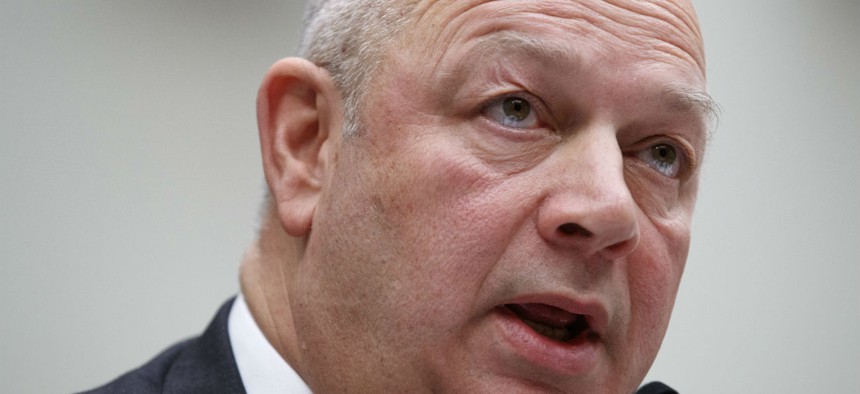
FAA Administrator Stephen Dickson testifies during a House Transportation Committee hearing on the Boeing 737 MAX on Dec. 11. Jacquelyn Martin/AP
Federal Aviation Administration Will Reconsider Agency’s Oversight of Boeing
“I witnessed a factory in chaos,” a former Boeing facility manager told lawmakers.
As part of the Federal Aviation Administration's ongoing investigations into two deadly Boeing 737 plane crashes five months apart, the agency’s top official told lawmakers on Wednesday he will weigh how government regulators oversee the Boeing facility that built the planes.
Following the crashes in October 2018 and March 2019 that killed a total of 346 people, the agency came under fire during a House Transportation and Infrastructure Committee hearing for its relaxed oversight of Boeing. When accused by Rep. Henry Johnson Jr., D-Ga., of “letting the fox guard the hen house,” FAA Administrator Stephen Dickson agreed that how the agency oversees Boeing’s staff is “something we need to look at.”
According to an October report by the Joint Authorities Technical Review, an independent international aviation panel, FAA had just 45 people overseeing the work of 1,500 employees at Boeing’s Organization Designation Authority, which is responsible for elements of the certification process. That oversight model was instituted in 2005 as part of the Bush administration’s deregulatory agenda. However, Dickson stated, “It’s not numbers as much as it is the skill set within the workforce.”
Ed Pierson, a former senior manager of Boeing’s facility in Renton, Washington, where the planes were built, described the working conditions at the hearing. “I witnessed a factory in chaos and reported serious concerns about production quality to senior Boeing leadership months before the first crash,” said Pierson. “I formally reported again before the second crash. No action was taken in response to either of my reports.” Pierson retired in August 2018, in part because he was distressed over conditions at the factory, according to The New York Times.
He depicted his outreach efforts to the agency as well as the Justice and Transportation departments and the National Transportation Safety Board, but said, “I have received no confirmation that any of my information concerning the state of the Renton factory has been shared with accident investigators.”
Dickson, who has been leading FAA since August, said he will review how agency staff oversee Boeing’s work. He said he is in the process of setting up an interview with Pierson who saw first hand the repercussions from limited federal oversight.
“I unequivocally support the dedicated professionals of the [Federal Aviation Administration] in continuing to adhere to data-driven, methodical analysis, review, and validation of the modified flight control systems and pilot training required to safely return the 737 MAX to commercial service,” said Dickson, referring to the system at the root of the crashes. “I have directed [FAA] employees to take whatever time is needed to do that work.”
During the hearing, the committee released a December 2018 internal agency analysis that predicted after the October 2018 crash there could be 15 more fatal crashes even after the agency issued an emergency warning about potential problems with the planes. While acknowledging that Dickson wasn’t in charge when the analysis was conducted, Chairman Rep. Peter DeFazio, D-Ore., said he expected Dickson to look into why it “never saw the light of day beyond the closed doors of the [agency]."







